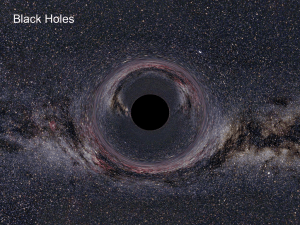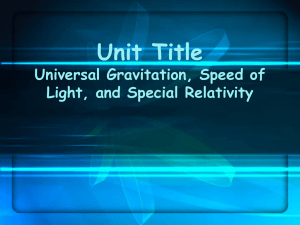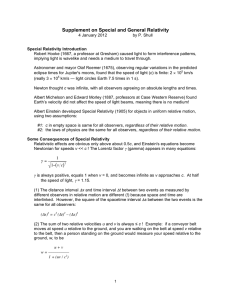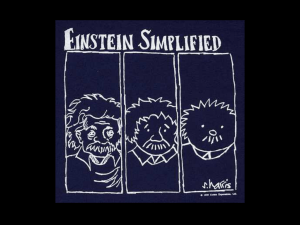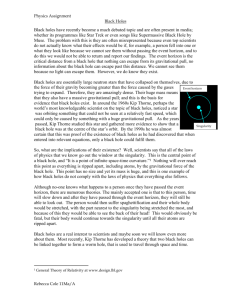Document 11136756
advertisement
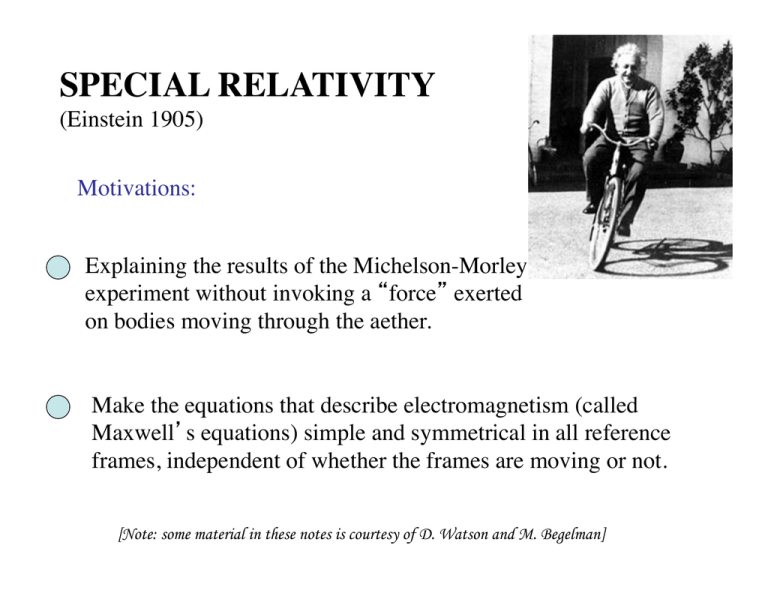
SPECIAL RELATIVITY (Einstein 1905) Motivations: Explaining the results of the Michelson-Morley experiment without invoking a “force” exerted on bodies moving through the aether. Make the equations that describe electromagnetism (called Maxwell’s equations) simple and symmetrical in all reference frames, independent of whether the frames are moving or not. [Note: some material in these notes is courtesy of D. Watson and M. Begelman] SPECIAL RELATIVITY (Einstein 1905) Based on two postulates: The RELATIVITY PRINCIPLE: the laws of physics are the same in all inertial frames. The CONSTANCY OF THE SPEED OF LIGHT: the speed of light, c=299,792 km/s, is the same for all inertial observers, independent of their velocity of motion relative to the source of light. SPECIAL = only applies to inertial reference frames, those for which the state of motion is not influenced by external forces SUMMARY OF THE PREDICTIONS OF THE THEORY OF SPECIAL RELATIVITY Relativity of Simultaneity Time dilation Δt = γΔt 0 [subscript “0” refers to the frame in which clock and meter are at rest] Length contraction along the direction of motion € L = L0 / γ Space and Time are relative €light, and add up in such a Velocities are relative, except for that of way that they never exceed the velocity of light. There is no reference frame in which light can appear to be at rest. Mass is relative and mass and energy are equivalent. SOME EXPERIMENTAL TESTS OF SPECIAL RELATIVITY High-energy particle accelerators: radioactive particles are seen to live much longer when moving at speed close than that of light than when at rest (direct probe of time dilation). No matter how much they are accelerated, they can never reach the speed of light. High-energy particle accelerator at Fermi Lab (near Chicago) Nuclear reactors/bombs: mass is converted in energy (E=mc2) GENERAL RELATIVITY - Einstein 1915 Starting problem: Special Relativity only applies to inertial reference frames, where no forces are involved. How to describe gravity then? [Note: some material in these notes courtesy of D. Watson and M. Begelman] Principle of Equivalence: Einstein 1907 (in Einstein’s own words: “The happiest thought of my life”) The effects of gravity are exactly equivalent to the effects of acceleration. Box stationary in gravity field = Box accelerates in empty space GENERAL RELATIVITY: (in a nutshell) Masses tell spacetime how to curve. Spacetime, with its curvature, tells masses how to move. [Image from “Spacetime and Gravity” by S. Carroll] [Image credit: NASA/ SUMMARY OF THE PREDICTIONS OF Gravitational Redshift Time Dilation EXPERIMENTAL TESTS OF GENERAL RELATIVITY Mercury’s Precession Gravitational Lensing Gravitational Redshift Gravitational Waves MERCURY’s PRECESSION The theory of General relativity was able to precisely account for the observed precession of Mercury’s orbit. Newtonian gravity [Image from www.gravitywarpdrive.com] General relativistic gravity (amount of precession not on scale - artist’s view of Mercury’s precession) GRAVITATIONAL DEFLECTION OF LIGHT During the eclipses, the beam of light from the star is deflected by the gravi- tational field of the Sun. Consequently, for the observer on Earth the position of the star appears to have shifted from its true position. First observational test of the prediction of General Relativity Two images of a distant quasar A B [Image credit: R. Ellis & I. Smail with HST (NASA/STScI)] The arches are the result of gravitational lensing [Image credit: P. Natarajan with HST (NASA/STScI)] GRAVITATIONAL REDSHIFT/TIME DILATION An atom emitting radiation at a particular frequency acts like an atomic clock. [Image credit: T. Arny] Sun more massive than Earth stronger gravity Compare identical atomic lines from Sun and Earth. Frequency of lines observed more redshifted for Sun than for Earth. GRAVITATIONAL WAVES [Image credit: K. Thorne & T. Carnahan] GRAVITATIONAL WAVES Ripples of spacetime curvature that propagate at the speed of light. A prediction of General Relativity: a “perturbation” of the spacetime curvature that propagates from the disturbance point. Analogy: dropping a stone (perturbation) in a pond (spacetime) produces waves in the water (spacetime ripples) that propagate. Sources of gravitational waves include: [drawing by Pulsations of Black Hole horizons; D. Watson] An imploding star; Merger of two compact objects (i.e. neutron stars, black holes); Two massive stars orbiting each other closely and rapidly. A brick under the effect of a gravitational wave If a brick were close to two merging black holes, it would be squeezed and stretched by as much as its size (humans would be killed!) For merging black holes in a far away galaxy at 1 billion years away, the size change due to the gravitational wave would be ~ 10-21 - very small! Gravitational Wave detectors: LIGO Kip Thorne Louisiana Washington BLACK HOLES [Image by A. Hamilton] Schwarzschild’s solution Describes the spacetime curvature near a massive, spherically symmetric body. Solution ONLY depends on BH MASS. [Figure from Thorne’s “Black Holes and Time warps”] Black Holes • To a stationary observer far away, time is dilated near a black hole, and at the critical surface (at RS), it is slowed down infinitely. • Light emitted close to the critical surface is severely red-shifted (the frequency is lower) and at the critical surface, the redshift is infinite. From inside this region no information can escape red-shifted red-shifted into oblivion [slide courtesy of M.Begelman] An observer at D = 1.5 Rs would be able to see the back of her head! [Image from “The Physical Universe” by F. Shu] Space around a spinning Black Hole [figure from Thorne’s “Black holes and time warps”] Because spacetime is “stuck” to the horizon, space is dragged along with the spin. This appears as a tornadolike swirl in hyperspace. STRUCTURE OF A SPINNING BLACK HOLE Two “surfaces”: The Horizon: region from which no signal can escape. The Ergosphere: region inside which space rotates so fast that is is impossible for a body to hover in such a way to appear stationary to a distant observer. [Image from “Gavity’s Fatal Attraction” by Begelman & Rees] The horizon is smaller: Rs/2 for max. spinning BHs IMPORTANCE OF KERR’S SOLUTION Kerr’s solution describes all black holes without electric charge. More generally: BLACK HOLES HAVE NO “HAIR” The only properties that describe a black hole are Mass Angular Momentum Charge Since astrophysical black holes are electrically neutral, Kerr’s solution can be considered the most general description of astrophysical black holes. NO “HAIR” THEOREM mass spin charge Heisenberg Uncertainty Principle • Another key element of quantum mechanics [This and next two slides courtesy of M. Begelman] • Goodbye to deterministic world • We cannot know/measure both the exact position and the exact velocity of a particle at the same time, i.e., if we measure one of the two quantities very accurately, the other one will be poorly determined. Δv Δv Δv • The uncertainty in position and velocity are linked by the fundamental Planck constant h (small!) Δx Δv = h Δx Δx Δx Fermions and the Pauli Principle • Two species of particles: Fermions and Bosons… • Bosons are social animals: the more the merrier • Fermions are individualists: only one of a kind in a given place with a given velocity BLACK HOLE THERMODYNAMICS Virtual particles in quantum mechanics Examples of particle-antiparticle pairs made from the vacuum: Electron Green photon Human Positron Green photon Anti-human 6x10-22 seconds 1x10-16 seconds Energy = 1.6x10-6 erg Energy = 8x10-12 erg 2x10-53 seconds Energy = 4.5x1025 erg [slide courtesy of D. Watson] HOW DOES THE HAWKING EFFECT WORK? “VACUUM FLUCTUATIONS” In the very short time that virtual pairs can exist... Tidal forces pull them apart Makes some of them real One falls in, one flies away Black hole evaporates [slide courtesy of M. Begelman] Creation of “virtual pairs” of particles Black hole evaporation Hawking radiation is emitted more efficiently if the tidal forces near the horizon are stronger, i.e. for smaller mass black holes. The temperature of a black hole is inversely proportional to its mass; therefore higher temperature means smaller mass. The evaporation time is proportional to (mass)3. Here are some typical evaporation times: 109 Msun BH: 1094 yr 2 Msun BH: 1067 yr 108 g BH: 1 sec At the final stage, when the BH temperature reaches trillions of K, the BH explodes. [simulation of BH explosion by A. Hamilton] STARS: how they are born, live and die [Image from “Gravity’s fatal attraction” by Begelman & Rees] STAR BIRTH CLOUDS IN M16 [Image by the Hubble Telescope - NASA] HOW STARS LIVE AND DIE The life and death of LOW-MASS STARS (i.e. our beloved Sun) Hubble images of PLANETARY NEBULAE [Images by the Hubble Telescope - NASA] Funky properties of white dwarf material 1 Kg chocolate cake 2 Kg chocolate cake 0.4 Msun white dwarf 0.8 Msun white dwarf HOW STARS DIE HIGH-MASS STARS Nuclear reactions proceed until core becomes Iron. Core collapses until density becomes so high that neutrons are packed very tightly and their degeneracy pressure supports against gravity NEUTRON STAR Neutron degeneracy pressure prevents further collapse Mmax~2-3 Msun [Image from “Gravity’s Fatal Attraction” by Begelman & Rees] … as seen by a telescope [Supernova 1987A, Anglo-Australian Observatory] What is left behind: SUPERNOVA REMNANT [Images from the Chandra Observatory] How does a pulsar “sound”? The Arecibo radio telescope [Audios courtesy of D. Nice] What happens if the Iron core of the collapsing star has a mass larger than 2-3 Msun? A BLACK HOLE IS BORN! [Image from http://archive.ncsa.uiuc.edu/Cyberia/NumRel/Images/hole.born.gif] Artist’s conception of an X-ray Binary [Image credit: NASA] NEUTRON STAR VS. BLACK HOLE IN AN X-RAY BINARY …how to tell • NS if: – Pulsing (X-ray pulsar) – Evidence of nuclear explosions on surface (X-ray burster) – Extra emission from its “hard” surface • BH if: – None of the above is seen – Mass M> 3Msun (the “smoking gun”) 1932: KARL JANSKY of identifying Is assigned the task the noise that plagued telephone calls to Europe 1935: noise is identified as coming from inner regions of Milky Way MANY YEARS GO BY……. 1960: a strong radio source is detected (3C48) Allan Sandage takes a spectrum in optical It’s the weirdest spectrum I have ever seen PUTTING IT TOGETHER • Variability • Energy output small size large mass COMBINATION OF SMALL SIZE AND LARGE MASS BLACK HOLE HOW CAN MASSIVE BLACK HOLES GENERATE SUCH A HIGH LUMINOSITY? By accreting mass through an accretion disk Via electromagnetic processes that tap the spin energy of the black hole (probably have to do with jet production) JETS: very common in Active Galaxies; often surrounded by radio lobes BIG open question: How are supermassive Black Holes formed? How it all started….. mid 1960s: VELA satellite … looking for signs of nuclear tests… TYPICAL GAMMA-RAY BURST Most GRB data gathered by BATSE in the 1990s Main properties of GRBs: Rates: about 1 per day Durations: from tens of milliseconds to several hundreds of seconds, with Long bimodal distribution Highly variable Isotropic distribution on the sky Short Our UNIVERSE: where it all came from…. [Image from “The Cosmic Perspective” by Bennett et al.] Formation of structure [Image from http://cosmicweb.uchicago.edu/filaments.html] • Universe expands from left to right • Matter collapses into filaments and clusters • Simulations show similar features compared to observations WHAT IS THE FATE OF OUR UNIVERSE? Observations suggest presence of repulsive force (“dark energy” or “cosmological constant”) Not everything that can be counted counts, and not everything that counts can be counted. - Albert Einstein

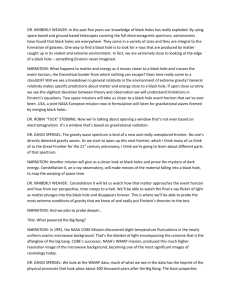

![BLACK HOLES [Image by A. Hamilton]](http://s2.studylib.net/store/data/011136746_1-55ad6d8c7967ea2fec5195cf1d23ce69-300x300.png)
